In the 16GB USB 3.0 Flash Drives for under $20 review last month, it was noted that the incredibly small Leef Supra 3.0 was a blazing fast contender. The only thing faster was the large SanDisk Extreme and that was the funny thing: SanDisk didn’t have a tiny USB 3.0 drive! Up until now, the only thing SanDisk had in this category was the Cruzer Fit, a USB 2.0 drive.
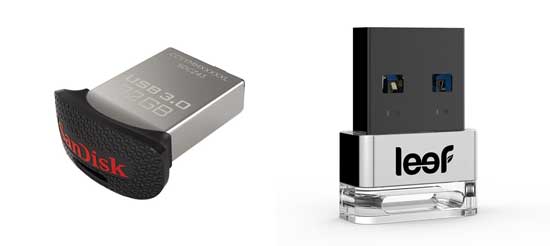 Well, SanDisk just released the Ultra Fit USB 3.0 drive which appears to be positioned exactly to compete against the Leef Supra 3.0. The question is “How does it perform?”
Well, SanDisk just released the Ultra Fit USB 3.0 drive which appears to be positioned exactly to compete against the Leef Supra 3.0. The question is “How does it perform?”
Let’s keep this article short-n-sweet and “cut to the chase.”
Benchmarks
To keep this a simple race, we put the SanDisk Ultra Fit up against the Leef Supra and added the SanDisk Cruzer Fit (a USB 2.0 drive) as an “anchor”.
It’s easy to see that the older Cruzer Fit lags behind both, entirely restricted by the USB 2.0 bus. The winner for sequential read speed is the Leef Supra 3.0 beating the SanDisk Ultra Fit handily at smaller blocksizes. At larger blocksizes (> 64KB), the gap is narrowed to only 2MB/sec, a mere 1.5% advantage. (Leef at 130MB/s -vs- SanDisk at 127MB/s)
The real surprise is with the random reads. The Leef Supra performs nearly as well as it did in the sequential reads (128MB/s). Meanwhile the SanDisk UltraFit tries to keep up, but struggles significantly (90MB/s) and takes a modest performance hit in comparison (30-40% slower).
Granted, random reads aren’t really the primary function of a USB Flash drive, but this is still surprising nonetheless. And if you are thinking of using a tiny USB drive as extra storage for a tablet or laptop, random read performance might be important.
When it comes to write speeds, the Leef is still very strong at the smaller blocksizes (<64KB), but the tables are turned as the SanDisk performs at a decent 18MB/sec edging out the Leef which comes up to around 16MB/sec (a 12% write speed advantage by the SanDisk). Interestingly enough, the USB 2.0 CruzerFit still performs solidly compared to the USB 3.0 drives at 12MB/sec.
Feature Comparison
| SanDisk Ultra Fit | Leef Supra 3.0 | |
| Max Read Speed | 127 MB/s | 130 MB/s |
| Max Write Speed | 18 MB/s | 16 MB/s |
| Activity LED | dim Red | bright White |
| Length | 19.1mm (0.75”) | 21.6mm (0.85”) |
| Warranty | 5-year | 5-year |
| 16GB | $14.00 | $16.00 |
| 32GB | $22.00 | $26.00 |
| 64GB | $42.00 | $55.00 |
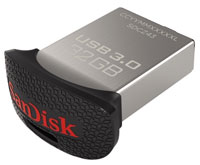 |
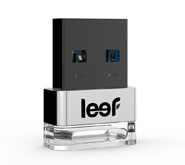 |
Conclusion
The straight truth is that both the SanDisk Ultra Fit and the Leef Supra are quite competitive. The Leef is a little stronger and better balanced (especially in the random read performance), but it also costs a little more.
Feature-wise, the SanDisk is a little more desirable being 2.5mm (1/10″) shorter and the dim red activity indicator light is unobtrusive compared to the Leef’s bright white LED.
Considering their sizes, they’re both really solid drives. In the end, the choice really comes down to personal preference. 🙂
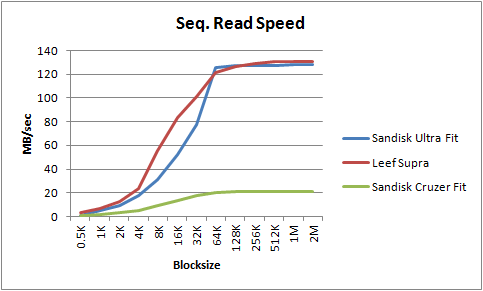
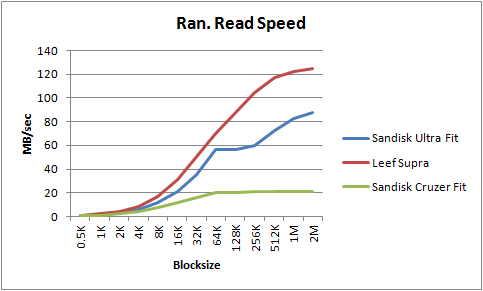
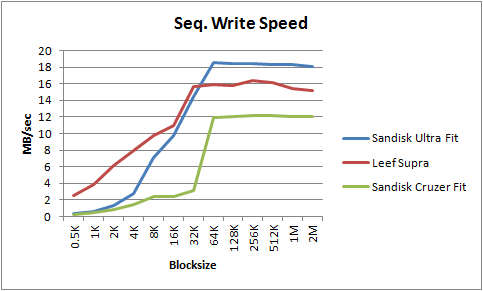

7 replies on “SanDisk Ultra Fit (SDCZ43) -vs- Leef Supra USB 3.0”
[…] UPDATE 25-SEPT-2014: The SanDisk Ultra Fit USB 3.0 drive is out! Read-on to find out how well the SanDisk Ultra Fit compares versus the Leef Supra 3.0. […]
No random write comparison?
Nope, I didn’t think it worthwhile given that (for the most part) files are just dragged and dropped onto flash drives. Random Write is hardly a common affair.
Hello Pretzel, have you ever described how you do your benchmarking? I’m trying to see how my USB sticks match up to the items you test and I’m just using xbench that just does 2k and 256k blocks. Looking at your graphs, it look like I won’t get a good idea how they compare to your max speeds.
My testing does, 512byte, 1k, 2, 4, 8, 16, 32, 64, 128, 256, 512, 1MB, etc.
Just find the block size in the graph and match up with your testing. 🙂
EDIT: Hmmm… yeah, I guess the graph is vague enough that it’s hard to get exact numbers. I suppose I could post them, but the problem I find with that is that it draws attention away from the general performance of the drive and brings focus back to the numbers and the smallest variations (which aren’t that important since there is variation in each test.)
Buying 200 GB Sandisk SD card for Vmware Windows 7 virtual disk. Wonder which of the smallest card readers performs the best. Ideas? Thanks!
It’s funny you mention this, but I actually did a review of them a year or so ago. https://www.pretzellogix.net/2014/09/13/which-portable-usb-3-0-sd-card-reader-is-the-best/
Check it out!